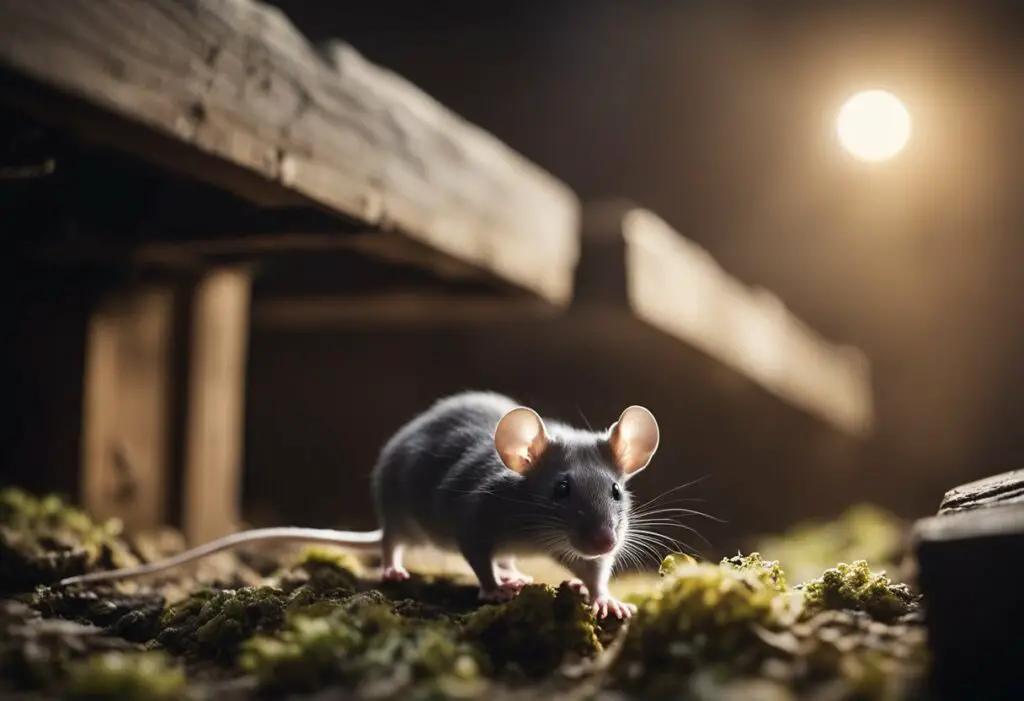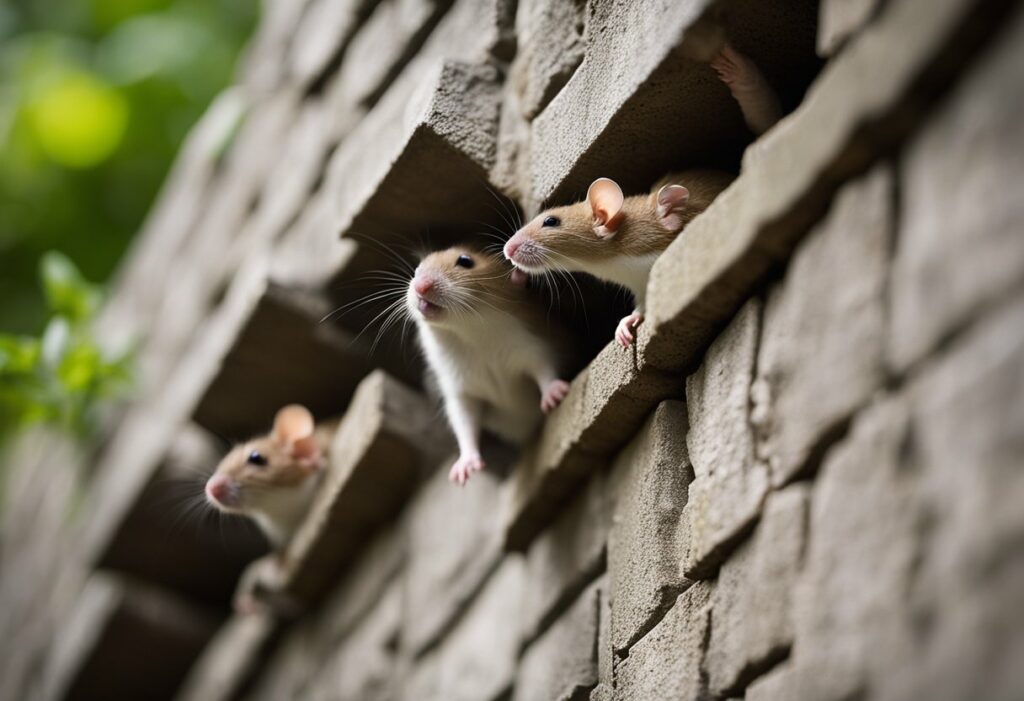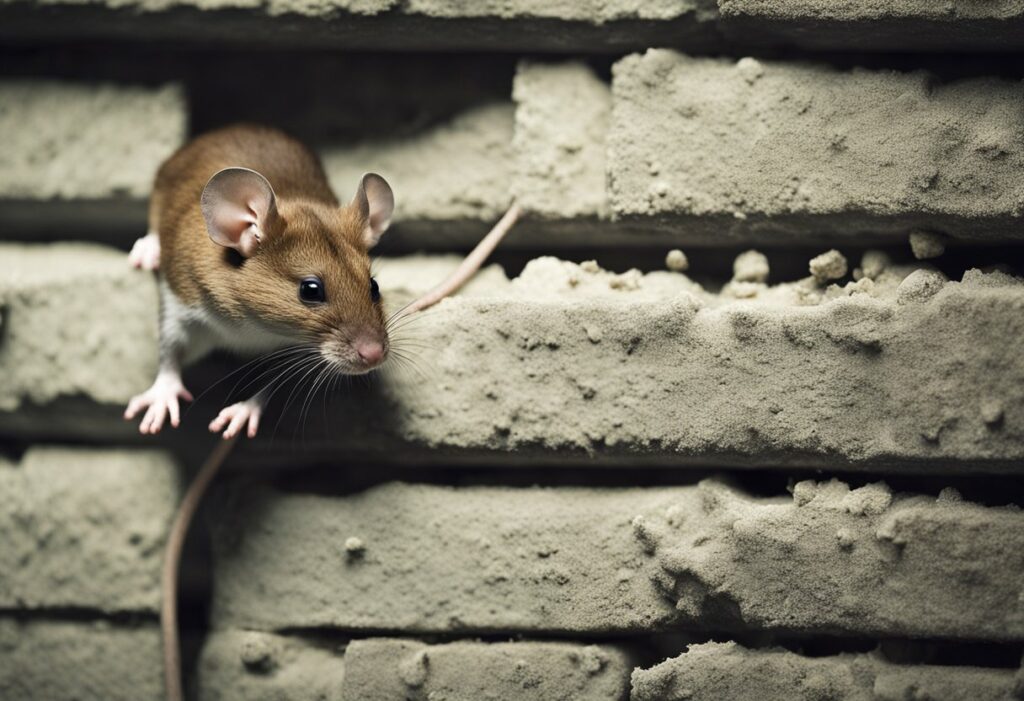Are you wondering whether mice can climb walls?
The short answer is yes, they can. Mice are known for their incredible climbing abilities, which allow them to scale vertical surfaces with ease. Whether it’s brick, wood, or even smooth surfaces like glass, mice can climb almost anything.

Mice are able to climb walls thanks to their strong claws and flexible bodies. Their claws allow them to grip onto surfaces, while their bodies are able to contort and adjust to different angles. Additionally, mice are able to jump up to 13 inches in height, which allows them to reach higher surfaces easily. So, if you have mice in your home, it’s important to take steps to prevent them from climbing walls and accessing other areas of your home.
Understanding Mouse Abilities
Mice are known for their impressive physical abilities, which allow them to climb, jump, and balance in ways that may surprise you. In this section, we’ll take a closer look at the different skills that mice possess.
Climbing Skills
One of the most impressive abilities of mice is their climbing skills. Mice can climb walls, trees, and even wires with ease. This is due to their sharp claws, which help them grip onto surfaces.
Mice also have a great sense of balance, which helps them climb even more efficiently. They use their tails as a counterbalance, which helps them maintain their center of gravity. This allows them to scale walls and other surfaces with ease.
Jumping and Balancing
In addition to their climbing skills, mice are also great jumpers. They can jump up to 18 inches vertically, which allows them to reach high surfaces that would otherwise be out of reach. They also have a great sense of balance, which helps them land on their feet after a jump.
Mice are like acrobats, using their physical abilities to navigate their environment and avoid predators. Their claws, grip, jumping, and balancing skills are all part of what makes them so adaptable and successful as a species.
Common Surfaces and Materials
When it comes to climbing, mice are incredibly agile creatures that can scale a wide variety of surfaces both indoors and outdoors. In this section, we’ll take a look at some of the most common surfaces and materials that mice can climb.
Indoor Climbing Surfaces
Mice can climb almost any indoor surface that provides enough grip, including wood, brick, drywall, plastic, and even metal. They can also climb vertically on objects such as pipes, wires, and PVC pipes. If you have a mouse problem in your home, it’s important to seal up any holes or gaps in your walls, floors, and ceilings to prevent them from climbing up and entering your living space.
One thing to note is that mice have a hard time climbing very smooth surfaces like glass. While they can navigate most textured surfaces with ease, they may struggle to climb up a completely smooth surface.
Outdoor Climbing Challenges
When it comes to outdoor climbing, mice face a few more challenges. While they can climb up most types of brick and concrete walls, they may struggle to climb up metal surfaces or smooth concrete walls. They can also climb trees and other outdoor objects but may have a harder time with surfaces that are wet or slippery.
If you want to prevent mice from climbing up the walls of your home, consider installing metal flashing or a slick barrier along the bottom of your walls. This can make it harder for them to get a grip and climb up.
In conclusion, mice are excellent climbers that can scale a wide variety of surfaces both indoors and outdoors. By understanding the surfaces and materials that mice can climb, you can take steps to prevent them from entering your home and causing damage.
Preventing and Addressing Infestations

If you suspect a mouse infestation in your home, it’s important to take action quickly to prevent the problem from getting worse. Here are some steps you can take to get rid of mice and prevent them from coming back.
Identifying Entry Points
The first step in preventing a mouse infestation is to identify and seal off any entry points. Mice can squeeze through gaps as small as a quarter of an inch, so it’s important to inspect your home thoroughly for any holes or cracks in walls, floors, or ceilings. Pay special attention to areas where pipes or wires enter your home, as these are common entry points for mice.
Once you’ve identified any entry points, seal them off with caulk, steel wool, or other materials that mice can’t chew through. You may also want to install door sweeps on exterior doors to prevent mice from entering your home.
Effective Mouse Traps and Deterrents
Trapping is one of the most effective ways to get rid of mice. Snap traps are a popular choice, but there are also humane traps available if you prefer to catch and release mice. Place traps in areas where you’ve seen mouse activity, such as along walls or in areas where you’ve found droppings.
In addition to traps, there are a variety of deterrents you can use to keep mice away. For example, cats are natural predators of mice and can help keep them out of your home. However, if you don’t have a cat or don’t want to get one, there are also ultrasonic repellents and other devices that emit high-frequency sounds that mice find unpleasant.
It’s also important to remove any potential food sources and hiding places for mice. Keep your home clean and free of clutter, and store food in airtight containers. Make sure to clean up any spills or crumbs right away, and don’t leave pet food out overnight.
If you’re having trouble getting rid of mice on your own, consider contacting a pest control company for professional help. They can help you identify and eradicate any nests or hiding places and can provide advice on how to mouse-proof your home in the future.
Mouse Behavior and Habitat
If you’re wondering whether mice can climb walls, it’s important to understand their behavior and habitat. House mice, for example, are common in many parts of the world and can cause significant damage to your home and garden. They are small, agile, and can fit through tiny spaces, making it easy for them to enter your home undetected.
Nesting and Feeding Habits
Mice are opportunistic feeders and will eat just about anything they can find, including seeds, grains, and even insects. They are also known to chew on a variety of materials, including wood, plastic, and electrical wires. This can lead to significant damage to your home and even pose a fire hazard.
When it comes to nesting, mice prefer warm, dark, and secluded spaces. They will often build their nests in crawl spaces, attics, and other hard-to-reach areas of your home. If you have a garden or yard, they may also build their nests outdoors, especially in areas with plenty of cover and food sources.
Signs of Mouse Presence
One of the most obvious signs of a mouse infestation is the presence of droppings. Mice produce a lot of fecal matter, and you may find their droppings in areas where they spend a lot of time, such as near their nests or feeding areas. You may also notice signs of chewing on wood or other materials, as well as gnaw marks on electrical wires.
If you suspect that you have a mouse infestation, it’s important to take action quickly. Mice can reproduce quickly, and a small infestation can quickly turn into a major problem. Look for signs of a mouse infestation, such as droppings, nests, and chewing, and take steps to eliminate the problem before it gets out of hand.
In conclusion, mice are agile creatures that can climb walls, but they prefer to build their nests in warm, dark, and secluded areas. Look for signs of a mouse infestation, such as droppings, nests, and chewing, and take steps to eliminate the problem before it gets out of hand.
DIY vs Professional Pest Control

If you’re dealing with a mouse infestation in your home, you might be wondering whether to tackle the problem yourself or to hire a professional pest control company. There are pros and cons to both options, so it’s important to consider your situation and preferences before making a decision.
When to Call the Experts
If you’ve tried various DIY methods and the mouse problem persists, it might be time to call in the professionals. Pest control companies have access to stronger chemicals and more effective traps than what you can buy at a store. They also have the expertise to identify and eradicate the source of the infestation, which can be difficult for a layperson to do.
Another reason to call in the experts is if you have a particularly large or persistent infestation. If you’ve been dealing with mice for a long time and have tried many different methods without success, it’s likely that the problem is more serious than you realize. A pest control company can assess the situation and come up with a comprehensive plan to eradicate the pests.
Home Remedies and Solutions
If you’re interested in tackling the mouse problem yourself, there are a few things you can try. One of the most effective DIY methods is setting snap traps around your home. These traps are cheap and widely available, and they can be very effective at catching mice. Make sure to place the traps in areas where you’ve seen mouse activity, such as along walls or near food sources.
Another DIY solution is to seal up any holes or cracks in your home that mice might be using to get in. You can use wire mesh or other materials to fill these gaps and prevent future infestations. It’s also a good idea to keep your home clean and free of food scraps, which can attract pests.
While DIY methods can be effective, they might not be enough to eradicate the problem completely. If you’re dealing with a large or persistent infestation, it’s best to call in the professionals. A pest control company can assess the situation and come up with a comprehensive plan to eradicate the pests. Additionally, if you have pets like dogs or cats, it’s important to be careful with any chemicals or traps you use to avoid harming them.
In conclusion, whether to tackle a mouse infestation yourself or to hire a professional pest control company is a personal decision that depends on your situation and preferences. While DIY methods can be effective, they might not be enough to eradicate the problem completely. If you’re dealing with a large or persistent infestation, it’s best to call in the professionals.








